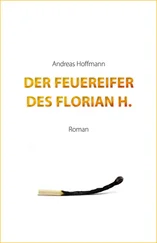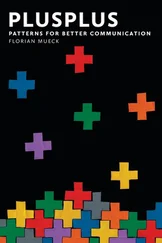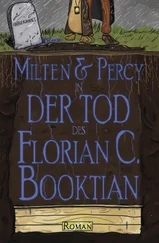Florian Cajori - William Oughtred
Здесь есть возможность читать онлайн «Florian Cajori - William Oughtred» — ознакомительный отрывок электронной книги совершенно бесплатно, а после прочтения отрывка купить полную версию. В некоторых случаях можно слушать аудио, скачать через торрент в формате fb2 и присутствует краткое содержание. Жанр: foreign_antique, foreign_prose, на английском языке. Описание произведения, (предисловие) а так же отзывы посетителей доступны на портале библиотеки ЛибКат.
- Название:William Oughtred
- Автор:
- Жанр:
- Год:неизвестен
- ISBN:нет данных
- Рейтинг книги:4 / 5. Голосов: 1
-
Избранное:Добавить в избранное
- Отзывы:
-
Ваша оценка:
- 80
- 1
- 2
- 3
- 4
- 5
William Oughtred: краткое содержание, описание и аннотация
Предлагаем к чтению аннотацию, описание, краткое содержание или предисловие (зависит от того, что написал сам автор книги «William Oughtred»). Если вы не нашли необходимую информацию о книге — напишите в комментариях, мы постараемся отыскать её.
William Oughtred — читать онлайн ознакомительный отрывок
Ниже представлен текст книги, разбитый по страницам. Система сохранения места последней прочитанной страницы, позволяет с удобством читать онлайн бесплатно книгу «William Oughtred», без необходимости каждый раз заново искать на чём Вы остановились. Поставьте закладку, и сможете в любой момент перейти на страницу, на которой закончили чтение.
Интервал:
Закладка:
As stated in this preface, one of his reasons for publishing the book, is
… that like Ariadne I might offer a thread to mathematical study by which the mysteries of this science might be revealed, and direction given to the best authors of antiquity, Euclid, Archimedes, the great geometrician Apollonius of Perga, and others, so as to be easily and thoroughly understood, their theorems being added, not only because to many they are the height and depth of mathematical science (I ignore the would-be mathematicians who occupy themselves only with the so-called practice, which is in reality mere juggler’s tricks with instruments, the surface so to speak, pursued with a disregard of the great art, a contemptible picture), but also to show with what keenness they have penetrated, with what mass of equations, comparisons, reductions, conversions and disquisitions these heroes have ornamented, increased and invented this most beautiful science.
The Clavis opens with an explanation of the Hindu-Arabic notation and of decimal fractions. Noteworthy is the absence of the words “million,” “billion,” etc. Though used on the Continent by certain mathematical writers long before this, these words did not become current in English mathematical books until the eighteenth century. The author was a great admirer of decimal fractions, but failed to introduce the notation which in later centuries came to be universally adopted. Oughtred wrote 0.56 in this manner 0|56; the point he used to designate ratio. Thus 3:4 was written by him 3·4. The decimal point (or comma) was first used by the inventor of logarithms, John Napier, as early as 1616 and 1617. Although Oughtred had mastered the theory of logarithms soon after their publication in 1614 and was a great admirer of Napier, he preferred to use the dot for the designation of ratio . This notation of ratio is used in all his mathematical books, except in two instances. The two dots (:) occur as symbols of ratio in some parts of Oughtred’s posthumous work, Opuscula mathematica hactenus inedita , Oxford, 1677, but may have been due to the editors and not to Oughtred himself. Then again the two dots (:) are used to designate ratio on the last two pages of the tables of the Latin edition of Oughtred’s Trigonometria of 1657. In all other parts of that book the dot (·) is used. Probably someone who supervised the printing of the tables introduced the (:) on the last two pages, following the logarithmic tables, where methods of interpolation are explained. The probability of this conjecture is the stronger, because in the English edition of the Trigonometrie , brought out the same year (1657) but after the Latin edition, the notation (:) at the end of the book is replaced by the usual (·), except that in some copies of the English edition the explanations at the end are omitted altogether.
Oughtred introduces an interesting, and at the same time new, feature of an abbreviated multiplication and an abbreviated division of decimal fractions. On this point he took a position far in advance of his time. The part on abbreviated multiplication was rewritten in slightly enlarged form and with some unimportant alterations in the later edition of the Clavis . We give it as it occurs in the revision. Four cases are given. In finding the product of 246|914 and 35|27, “if you would have the Product without any Parts” (without any decimal part), “set the place of Unity of the lesser under the place of Unity in the greater: as in the Example,” writing the figures of the lesser number in inverse order . From the example it will be seen that he begins by multiplying by 3, the right-hand digit of the multiplier. In the first edition of the Clavis he began with 7, the left digit. Observe also that he “carries” the nearest tens in the product of each lower digit and the upper digit one place to its right. For instance, he takes 7×4=28 and carries 3, then he finds 7×2+3=17 and writes down 17.
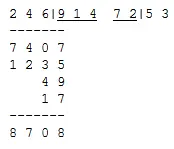
The second case supposes that “you would have the Product with some places of parts” (decimals), say 4: “Set the place of Unity of the lesser Number under the Fourth place of the Parts of the greater.” The multiplication of 246|914 by 35|27 is now performed thus:
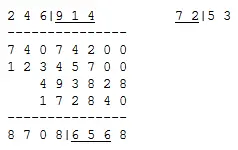
In the third and fourth cases are considered factors which appear as integers, but are in reality decimals; for instance, the sine of 54° is given in the tables as 80902 when in reality it is .80902.
Of interest as regards the use of the word “parabola” is the following: “The Number found by Division is called the Quotient , or also Parabola , because it arises out of the Application of a plain Number to a given Longitude, that a congruous Latitude may be found.” 26This is in harmony with etymological dictionaries which speak of a parabola as the application of a given area to a given straight line. The dividend or product is the area; the divisor or factor is the line.
Oughtred gives two processes of long division. The first is identical with the modern process, except that the divisor is written below every remainder, each digit of the divisor being crossed out as soon as it has been used in the partial multiplication. The second method of long division is one of the several types of the old “scratch method.” This antiquated process held its place by the side of the modern method in all editions of the Clavis . The author divides 467023 by 357|0926425, giving the following instructions: “Take as many of the first Figures of the Divisor as are necessary, for the first Divisor, and then in every following particular Division drop one of the Figures of the Divisor towards the Left Hand, till you have got a competent Quotient.” He does not explain abbreviated division as thoroughly as abbreviated multiplication.

Oughtred does not examine the degree of reliability or accuracy of his processes of abbreviated multiplication and division. Here as in other places he gives in condensed statement the mode of procedure, without further discussion.
He does not attempt to establish the rules for the addition, subtraction, multiplication, and division of positive and negative numbers. “If the Signs are both alike, the Product will be affirmative, if unlike, negative”; then he proceeds to applications. This attitude is superior to that of many writers of the eighteenth and nineteenth centuries, on pedagogical as well as logical grounds: pedagogically, because the beginner in the study of algebra is not in a position to appreciate an abstract train of thought, as every teacher well knows, and derives better intellectual exercise from the applications of the rules to problems; logically, because the rule of signs in multiplication does not admit of rigorous proof, unless some other assumption is first made which is no less arbitrary than the rule itself. It is well known that the proofs of the rule of signs given by eighteenth-century writers are invalid. Somewhere they involve some surreptitious assumption. This criticism applies even to the proof given by Laplace, which tacitly assumes the distributive law in multiplication.
A word should be said on Oughtred’s definition of + and – . He recognizes their double function in algebra by saying ( Clavis , 1631, p. 2): “Signum additionis, sive affirmationis, est + plus” and “Signum subductionis, sive negationis est – minus.” They are symbols which indicate the quality of numbers in some instances and operations of addition or subtraction in other instances. In the 1694 edition of the Clavis , thirty-four years after the death of Oughtred, these symbols are defined as signifying operations only, but are actually used to signify the quality of numbers as well. In this respect the 1694 edition marks a recrudescence.
Читать дальшеИнтервал:
Закладка:
Похожие книги на «William Oughtred»
Представляем Вашему вниманию похожие книги на «William Oughtred» списком для выбора. Мы отобрали схожую по названию и смыслу литературу в надежде предоставить читателям больше вариантов отыскать новые, интересные, ещё непрочитанные произведения.
Обсуждение, отзывы о книге «William Oughtred» и просто собственные мнения читателей. Оставьте ваши комментарии, напишите, что Вы думаете о произведении, его смысле или главных героях. Укажите что конкретно понравилось, а что нет, и почему Вы так считаете.



